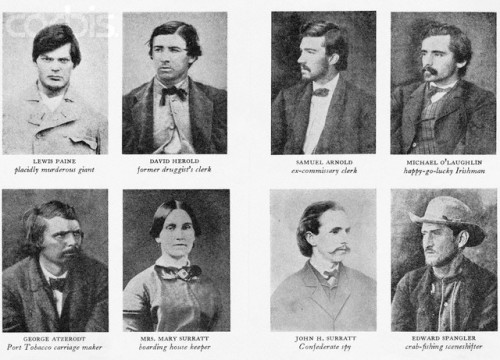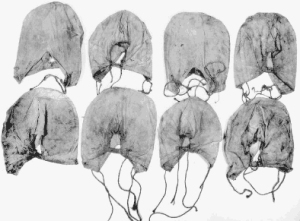After the assassination of Lincoln and the attempted assassination of Secretary of State William Seward, Secretary of War Edwin Stanton doggedly pursued the apprehension and prosecution of the conspirators. From the beginning, he knew that actor John Wilkes Booth had murdered the president. Booth was hunted down and killed on April 26, 1865, only eleven days after the asssasination. In the search for Booth’s co-conspirators, dozens of suspects were soon arrested and detained. It was determined that the attack had been a Confederate conspiracy designed to topple the United States government, and was, thus, an act of war. It was decided then that the proceedings would be handled by a military tribunal, and, therefore, be under Stanton’s control.

Eight of Lincoln Assassination Conspirators
Ultimately, the suspects were narrowed down to seven men and one woman: Samuel Arnold, George Atzerodt, David Herold, Samuel Mudd, Michael O’Laughlen, Lewis Powell, Edmund Spangler, and Mary Surratt.
Extraordinary security measures were taken with the prisoners. Mary Surratt and Dr. Samuel Mudd first were jailed at the Old Capitol Prison, while the other six were imprisoned on the ironclad ships the Montauk and Saugus. They were all later confined to separate cells in the Old Arsenal Penitentiary. Stanton had no tolerance for traitors; he had built a reputation as the secretary of war for ruthlessly rooting out Confederate sympathizers and prosecuting them harshly. Matter of fact,
Lincoln’s last act as President was overriding Stanton’s decision supporting the execution of George S.E. Vaughn for spying. Lincoln pardoned Vaughn an hour before he was assassinated.

Canvas Hoods Worn by Lincoln Assassination Conspirators before Trial July 7, 1865
“Stanton ordered an unusual form of isolation for the eight suspects. He ordered eight heavy canvas hoods made, padded one-inch thick with cotton, with one small hole for eating, no opening for eyes or ears. Stanton ordered that the bags be worn by the seven men day and night as a preventive to conversation. Hood number eight was never used on Mrs. Surratt, the owner of the boarding house where the conspirators had laid their plans, Stanton knew the furor of indignation that would cause. A ball of extra cotton padding covered the eyes so that there was painful pressure on the closed lids. No baths or washing of any kind were allowed, and during the hot breathless weeks of the trial the prisoners’ faces became more swollen and bloated by the day, and even the prison doctor began to fear for the conspirators’ sanity inside those heavy hoods laced so tight around their necks. But Stanton would not allow them to be removed, nor the rigid wrist irons, nor the anklets, each of which was connected to an iron ball weighing seventy-five pounds.”(1)
(1) Stanton, Edwin M. Wikipedia. http://en.wikipedia.org/wiki/Edwin_M._Stanton


















